This interview is part of a series of interviews with European craftspeople conducted in collaboration between FRH, the European network for religious heritage, and Mad’in Europe, the network of European fine and traditional crafts and cultural heritage restoration professions.
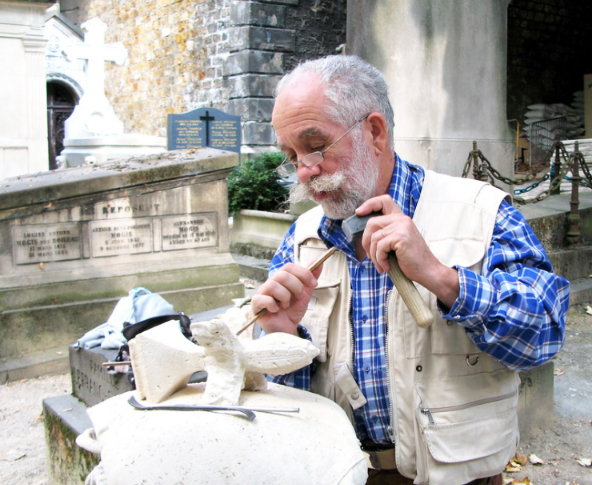
Hugues de Bazelaire working © Mad’in Europe/Hugues de Bazelaire
1. Please introduce yourself (profession, area of expertise and years of experience).
My name is Hugues de Bazelaire. I’ve been a conservator-restorer, stone cutter and sculptor for over 50 years. I am specialised in architecture and monumental sculpture.
As a son and grandson of architects, I’ve always been very interested in historic buildings. I was first employed as a mason, and later dived into the world of stonework. I was involved in stone-setting, stereotomy but also sculpture, in churches. Today I often intervene as an expert for appraisals, which means assessing the condition of a work by listing the do’s and don’ts.
2. What clients/markets do you work with (are they local, national or international)? Which needs does your work generally tackle? Which are the required skills and certifications that your customers request?
My clients are either private or public. I go where there’s a need. I’ve done a lot of work for the Louvre, where I moved 2 large Renaissance portals and carried out an archaeological study, which means researching the materials used, their origin and the technique used. I’ve also done a lot of work for the Versailles estate.
3. Please briefly explain how your profession is related to religious heritage and/or cultural heritage.
Half of my time is devoted to religious heritage. I’m currently working at the Chapelle Royale in Dreux, where I have been designated to preserve a statue of Saint Louis that has been badly damaged.
I’ve worked on various religious heritage projects, including a mosque in Yemen before the Gulf War, and I’ve also done some voluntary work as a consultant for the Versailles synagogue.
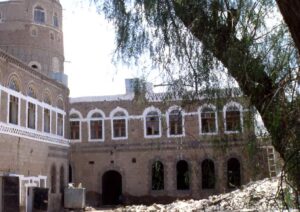
Restoration of the stuccowork of a 12th-century mosque in Yemen© Mad’in Europe/Hugues de Bazelaire
4. Please describe the main steps of your usual working process and the materials that you use most.
I mainly use natural materials: stone, marble, clay, anything that can be found in nature. I also use transformed materials: terracotta, glues and metals for restoring copper and brass instruments. I try to use as much local, hard stone as possible.
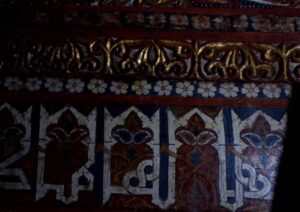
Restoration of the stuccowork of a 12th-century mosque in Yemen© Mad’in Europe/Hugues de Bazelaire
I use other materials to treat the work, i.e. biocides to kill moss, lichen and other bacteria that damage the stone. I also use lasers to clean the work. All these materials are adapted to their intended use, and that is the most important thing.
As for my working process, I start by examining the work in order to determine its condition. My duty is to find a way to bring it back to life and even multiply it. The scope of my work is so broad that I cannot define fixed stages. It varies greatly from one work to another: it can range from re-burnishing to cleaning or recasting.
5. Do you regularly cooperate with craft professionals from other fields? If yes, can you explain which ones and why?
When a work is not fully in my area of expertise, I call on other more competent craftsmen, for example fellow painting restorers. Sometimes there are groupings, i.e. we join forces with several colleagues for a contract. I also work a lot with archaeologists and art historians.
6. Please mention any innovation that helped improve your work (technological, digital, material related, legal…) and explain the impact they had on your profession.
In Venice, at the European Training Centre for Architectural Heritage Craftsmen, I learnt how to make copies using a fine-tuning technique, i.e. looking for points on a sculpture using a needle. Nowadays, we also carry out 3D modeling, controlled by machines capable of cutting the stone themselves. But the finishing work still has to be done by the sculptor. 3D printers can also be used to make reductions or virtual reality reconstructions.
Some time ago, I also took part in the development of a laser used to clean the works. This innovation has enabled my colleagues to clean the relief plans of the Invalides in Paris, for example. This kind of innovation was made possible thanks to a close collaboration with engineers from the Museums of France and the Historic Monuments Research Laboratory in Champs-sur-Marne.
Traditional methods, which are 2,500 years old, still have the advantage of being less expensive than the new ones, which depend on computer technology.
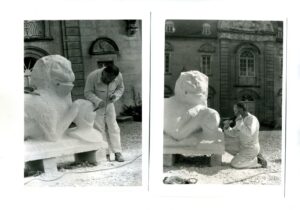
New limestone cut of two monumental lions in front of the Château de Buthiers, Doubs.© Mad’in Europe/Hugues de Bazelaire
7. How did you learn the profession? Can you detail your learning path mentioning schools and workshops where you were trained?
On a technical level, I have a vocational training certificate in masonry for historic monuments. But more importantly I come from a family where art is essential, and everyone is very attached to manual work. After my vocational training certificate, I started training in stone-cutting. I also did a lot of drawings.
Then I took a Master’s degree at Paris 1 Panthéon Sorbonne.
I learnt a lot on the field. I never stopped continuing my training while working, as I did at the French Institute for the Restoration of Works of Art where I took classes.
8. Do you pass on your knowledge to young people? If yes, how? In schools, through workshops…?
I’ve passed on my knowledge a lot to young people during my career, and I still do. For example, I’ve taught heritage classes in secondary schools. I was also a sculpture teacher in Arras, where I taught sculpture creation as well as modeling. I also receive a lot of trainees in my workshop, between 4 and 6 each year.
9. What would you recommend to a young person interested in your profession? What are the opportunities and areas in which they can work with your skills?
Many young people are trained in Art History and therefore have a particular interest in heritage. However, they sometimes lack training in the history of techniques, which should not be overlooked.
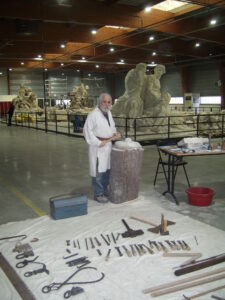
Hugues De Bazelaire at work. ©Mad’in Europe/Hugues de Bazelaire
I would also advise them to watch out for the tricky invitations to tender that can arise in the course of their careers. In spite of everything, my profession remains one in which there’s never a dull moment, because there are so many challenges to be met. It’s a job that has almost a paramedical dimension: we treat works of art, we treat them for the illnesses they have.
10. Which are the threats that may endanger your profession? Can you mention some difficulties that are associated with your work? Which could be the solutions to better support your profession and preserve the transmission of skills?
The individual worker is in danger because he is struggling to compete with the big companies. These companies buy raw materials at wholesale prices, which enables them to offer much more competitive prices than the self-employed professionals like me. The price of stone is killing the trade because it considerably increases the cost price. As a result, companies are increasingly becoming large structures with very strong economic resources that threaten small quarries by buying them up.
The reduction in the number of quarries means a reduction in the quality and diversity of the stone that can be found.
However I definitely see a bright future for the stone cutting profession. Over the last twenty years or so there has been a revival of traditional trades, thanks to the possibilities offered by stone materials in all areas of design.
You can find out more about Hugues de Bazelaire’s work on Mad’in Europe’s website as well as on Facebook and LinkedIn.
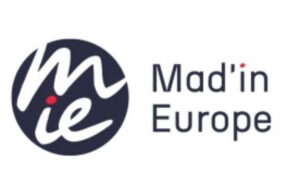 Mad’in Europe (MIE) is a small company committed to promoting craft professionals and crafts professions and to supporting the transmission of crafts skills at a European level. Its multilingual portal gathers a large audience around the profiles of 1,500 crafts, restorers and fine crafts professionals. As a member of some European organizations and thanks to its wide European network MIE participates in several transversal activities including Erasmus and Horizon projects which focus on valorisation of crafts, preservation of traditional know-how, and raising awareness among young people, for whom the sector represents a source of employment.
Mad’in Europe (MIE) is a small company committed to promoting craft professionals and crafts professions and to supporting the transmission of crafts skills at a European level. Its multilingual portal gathers a large audience around the profiles of 1,500 crafts, restorers and fine crafts professionals. As a member of some European organizations and thanks to its wide European network MIE participates in several transversal activities including Erasmus and Horizon projects which focus on valorisation of crafts, preservation of traditional know-how, and raising awareness among young people, for whom the sector represents a source of employment.
 Future for Religious Heritage (FRH) is an independent, non-faith, non-profit European network founded in 2011 and based in Brussels to promote, encourage and support the safeguard, maintenance, conservation, restoration, accessibility and embellishment of historic places of worship. Our network represents more than 80 organisations and over 120 professionals from 36 countries, which includes NGOs, governmental organisations, religious and university departments, and individuals. We are one of the 36 European networks currently supported by the Creative Europe Networks programme.
Future for Religious Heritage (FRH) is an independent, non-faith, non-profit European network founded in 2011 and based in Brussels to promote, encourage and support the safeguard, maintenance, conservation, restoration, accessibility and embellishment of historic places of worship. Our network represents more than 80 organisations and over 120 professionals from 36 countries, which includes NGOs, governmental organisations, religious and university departments, and individuals. We are one of the 36 European networks currently supported by the Creative Europe Networks programme.





Follow us: